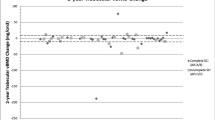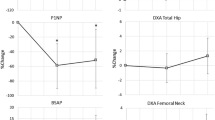Abstract
Summary
We explored the association between adiponectin levels and bone strength in paralyzed men with spinal cord injury. We found that bone strength was inversely associated with circulating adiponectin levels. Thus, strength estimates and adiponectin levels may improve fracture risk prediction and detection of response to osteogenic therapies following spinal cord injury.
Purpose
Previous research has demonstrated an inverse relationship between circulating adiponectin and bone mineral density, suggesting that adiponectin may be used as a biomarker for bone health. However, this relationship may reflect indirect effects on bone metabolism via adipose-mediated mechanical pathways rather than the direct effects of adipokines on bone metabolism. Thus, we explored the association between circulating adiponectin levels and bone strength in 27 men with spinal cord injury.
Methods
Plasma adiponectin levels were quantified by ELISA assay. Axial stiffness and maximal load to fracture of the distal femur were quantified via finite element analysis using reconstructed 3D models of volumetric CT scans. We also collected information on timing, location, and cause of previous fractures.
Results
Axial stiffness and maximal load were inversely associated with circulating adiponectin levels (R 2 = 0.44, p = 0.01; R 2 = 0.58, p = 0.05) after adjusting for injury duration and lower extremity lean mass. In individuals with post-SCI osteoporotic fractures, distal femur stiffness (p = 0.01) and maximal load (p = 0.005) were lower, and adiponectin was higher (p = 0.04) than those with no fracture history.
Conclusions
Based on these findings, strength estimates may improve fracture risk prediction and detection of response to osteogenic therapies following spinal cord injury. Furthermore, our findings suggest that circulating adiponectin may indeed be a feasible biomarker for bone health and osteoporotic fracture risk in paralyzed individuals with spinal cord injury.

Similar content being viewed by others
References
Reid IR (2008) Relationships between fat and bone. Osteoporos Int 19:595–606
Schafer AL, Sellmeyer DE, Schwartz AV, Rosen CJ, Vittinghoff E, Palermo L, Bilezikian JP, Shoback DM, Black DM (2011) Change in undercarboxylated osteocalcin is associated with changes in body weight, fat mass, and adiponectin: parathyroid hormone (1–84) or alendronate therapy in postmenopausal women with osteoporosis (the PaTH study). J Clin Endocrinol Metab 96:E1982–E1989
Zhang Y, Zhou P, Kimondo JW (2012) Adiponectin and osteocalcin: relation to insulin sensitivity. Biochem Cell Biol 90:613–620
Balemans W, Ebeling M, Patel N, Van HE, Olson P, Dioszegi M, Lacza C, Wuyts W, Van Den EJ, Willems P, Paes-Alves AF, Hill S, Bueno M, Ramos FJ, Tacconi P, Dikkers FG, Stratakis C, Lindpaintner K, Vickery B, Foernzler D, Van HW (2001) Increased bone density in sclerosteosis is due to the deficiency of a novel secreted protein (SOST). Hum Mol Genet 10:537–543
Li X, Ominsky MS, Niu QT, Sun N, Daugherty B, D’Agostin D, Kurahara C, Gao Y, Cao J, Gong J, Asuncion F, Barrero M, Warmington K, Dwyer D, Stolina M, Morony S, Sarosi I, Kostenuik PJ, Lacey DL, Simonet WS, Ke HZ, Paszty C (2008) Targeted deletion of the sclerostin gene in mice results in increased bone formation and bone strength. J Bone Miner Res 23:860–869
Johansson H, Oden A, Lerner UH, Jutberger H, Lorentzon M, Barrett-Connor E, Karlsson MK, Ljunggren O, Smith U, McCloskey E, Kanis JA, Ohlsson C, Mellstrom D (2012) High serum adiponectin predicts incident fractures in elderly men: osteoporotic fractures in men (MrOS) Sweden. J Bone Miner Res 27:1390–1396
Berner HS, Lyngstadaas SP, Spahr A, Monjo M, Thommesen L, Drevon CA, Syversen U, Reseland JE (2004) Adiponectin and its receptors are expressed in bone-forming cells. Bone 35:842–849
Yokota T, Meka CS, Medina KL, Igarashi H, Comp PC, Takahashi M, Nishida M, Oritani K, Miyagawa J, Funahashi T, Tomiyama Y, Matsuzawa Y, Kincade PW (2002) Paracrine regulation of fat cell formation in bone marrow cultures via adiponectin and prostaglandins. J Clin Invest 109:1303–1310
Luo XH, Guo LJ, Yuan LQ, Xie H, Zhou HD, Wu XP, Liao EY (2005) Adiponectin stimulates human osteoblasts proliferation and differentiation via the MAPK signaling pathway. Exp Cell Res 309:99–109
Luo XH, Guo LJ, Xie H, Yuan LQ, Wu XP, Zhou HD, Liao EY (2006) Adiponectin stimulates RANKL and inhibits OPG expression in human osteoblasts through the MAPK signaling pathway. J Bone Miner Res 21:1648–1656
Jurimae J, Jurimae T (2007) Adiponectin is a predictor of bone mineral density in middle-aged premenopausal women. Osteoporos Int 18:1253–1259
Jurimae J, Jurimae T (2007) Plasma adiponectin concentration in healthy pre- and postmenopausal women: relationship with body composition, bone mineral, and metabolic variables. Am J Physiol Endocrinol Metab 293:E42–E47
Richards JB, Valdes AM, Burling K, Perks UC, Spector TD (2007) Serum adiponectin and bone mineral density in women. J Clin Endocrinol Metab 92:1517–1523
Basurto L, Galvan R, Cordova N, Saucedo R, Vargas C, Campos S, Halley E, Avelar F, Zarate A (2009) Adiponectin is associated with low bone mineral density in elderly men. Eur J Endocrinol 160:289–293
Peng XD, Xie H, Zhao Q, Wu XP, Sun ZQ, Liao EY (2008) Relationships between serum adiponectin, leptin, resistin, visfatin levels and bone mineral density, and bone biochemical markers in Chinese men. Clin Chim Acta 387:31–35
Baldock P (2011) Reciprocal regulation of bone and energy metabolism. Horm Res Paediatr 76(Suppl 1):7–11
Doherty AL, Battaglino RA, Donovan J, Gagnon D, Lazzari AA, Garshick E, Zafonte R, Morse LR (2014) Adiponectin is a candidate biomarker of lower extremity bone density in men with chronic spinal cord injury. J Bone Miner Res 29:251–259
Friedman AW (2006) Important determinants of bone strength: beyond bone mineral density. J Clin Rheumatol 12:70–77
Tuukkanen J, Koivukangas A, Jamsa T, Sundquist K, Mackay CA, Marks SC Jr (2000) Mineral density and bone strength are dissociated in long bones of rat osteopetrotic mutations. J Bone Miner Res 15:1905–1911
Morse LR, Lazzari AA, Battaglino R, Stolzmann KL, Matthess KR, Gagnon DR, Davis SA, Garshick E (2009) Dual energy X-ray absorptiometry of the distal femur may be more reliable than the proximal tibia in spinal cord injury. Arch Phys Med Rehabil 90:827–831
Shapiro LG, Stockman GC, (2001) Computer Vision. Prentice-Hall, Upper Saddle River
Fang Q, Boas D. (2009) Tetrahedral mesh generation from volumetric binary and gray-scale images. Proc Intern Symp Biomed Imaging 1142–1145
Cody DD, Gross GJ, Hou FJ, Spencer HJ, Goldstein SA, Fyhrie DP (1999) Femoral strength is better predicted by finite element models than QCT and DXA. J Biomech 32:1013–1020
Huiskes R, Chao EY (1983) A survey of finite element analysis in orthopedic biomechanics: the first decade. J Biomech 16:385–409
Keyak JH, Rossi SA, Jones KA, Skinner HB (1998) Prediction of femoral fracture load using automated finite element modeling. J Biomech 31:125–133
Dreiseitl S, Ohno-Machado L, Vinterbo S. (1999) Evaluating variable selection methods for diagnosis of myocardial infarction. Proc AMIA Symp 246–250
Steyerberg EW, Eijkemans MJ, Habbema JD (1999) Stepwise selection in small data sets: a simulation study of bias in logistic regression analysis. J Clin Epidemiol 52:935–942
Agbaht K, Gurlek A, Karakaya J, Bayraktar M (2009) Circulating adiponectin represents a biomarker of the association between adiposity and bone mineral density. Endocrine 35:371–379
Barbour KE, Zmuda JM, Boudreau R, Strotmeyer ES, Horwitz MJ, Evans RW, Kanaya AM, Harris TB, Cauley JA (2012) The effects of adiponectin and leptin on changes in bone mineral density. Osteoporos Int 23:1699–1710
Huang KC, Cheng WC, Yen RF, Tsai KS, Tai TY, Yang WS (2004) Lack of independent relationship between plasma adiponectin, leptin levels and bone density in nondiabetic female adolescents. Clin Endocrinol (Oxf) 61:204–208
Iacobellis G, Iorio M, Napoli N, Cotesta D, Zinnamosca L, Marinelli C, Petramala L, Minisola S, D’Erasmo E, Letizia C (2011) Relation of adiponectin, visfatin and bone mineral density in patients with metabolic syndrome. J Endocrinol Investig 34:e12–e15
Jurimae J, Jurimae T, Leppik A, Kums T (2008) The influence of ghrelin, adiponectin, and leptin on bone mineral density in healthy postmenopausal women. J Bone Miner Metab 26:618–623
Kanazawa I, Yamaguchi T, Yamamoto M, Yamauchi M, Yano S, Sugimoto T (2009) Relationships between serum adiponectin levels versus bone mineral density, bone metabolic markers, and vertebral fractures in type 2 diabetes mellitus. Eur J Endocrinol 160:265–273
Bauman WA, Spungen AM, Wang J, Pierson RN Jr, Schwartz E (2006) Relationship of fat mass and serum estradiol with lower extremity bone in persons with chronic spinal cord injury. Am J Physiol Endocrinol Metab 209:E1098–E1103
Misra M, Klibanski A (2013) Anorexia nervosa, obesity and bone metabolism. Pediatr Endocrinol Rev 11:21–33
Martin RB (1991) Determinants of the mechanical properties of bones. J Biomech 24(Suppl 1):79–88
Barbour KE, Zmuda JM, Boudreau R, Strotmeyer ES, Horwitz MJ, Evans RW, Kanaya AM, Harris TB, Bauer DC, Cauley JA (2011) Adipokines and the risk of fracture in older adults. J Bone Miner Res 26:1568–1576
Jurimae J, Kums T, Jurimae T (2009) Adipocytokine and ghrelin levels in relation to bone mineral density in physically active older women: longitudinal associations. Eur J Endocrinol 160:381–385
Wheater G, Elshahaly M, Tuck SP, Datta HK, van Laar JM (2013) The clinical utility of bone marker measurements in osteoporosis. J Transl Med 11:201
Morse LR, Sudhakar S, Lazzari AA, Tun C, Garshick E, Zafonte R, Battaglino RA (2013) Sclerostin: a candidate biomarker of SCI-induced osteoporosis. Osteoporos Int 24:961–968
Dauty M, Perrouin VB, Maugars Y, Dubois C, Mathe JF (2000) Supralesional and sublesional bone mineral density in spinal cord-injured patients. Bone 27:305–309
Garland DE, Stewart CA, Adkins RH, Hu SS, Rosen C, Liotta FJ, Weinstein DA (1992) Osteoporosis after spinal cord injury. J Orthop Res 10:371–378
Vestergaard P, Krogh K, Rejnmark L, Mosekilde L (1998) Fracture rates and risk factors for fractures in patients with spinal cord injury. Spinal Cord 36:790–796
Acknowledgments
We thank Sam Davis, clinical research coordinator and technician, Boston VA Healthcare System, for assisting with bone density scans; and Rachael Burns and Kara Loo, research assistants, Boston VA Healthcare System, for collection of anthropometric data. This study received support from the Department of Defense (W81XWH-10-1-1043), the National Institute of Arthritis and Musculoskeletal and Skin Diseases (1R01AR059270-01), and the Department of Education, National Institute on Disability and Rehabilitation Research (H133N110010).
Conflicts of interest
None
Author information
Authors and Affiliations
Corresponding author
Rights and permissions
About this article
Cite this article
Tan, C.O., Battaglino, R.A., Doherty, A.L. et al. Adiponectin is associated with bone strength and fracture history in paralyzed men with spinal cord injury. Osteoporos Int 25, 2599–2607 (2014). https://doi.org/10.1007/s00198-014-2786-2
Received:
Accepted:
Published:
Issue Date:
DOI: https://doi.org/10.1007/s00198-014-2786-2




